We’ve covered all the flavors of Magento and Shopify in the past — but this article is different.
Here, we’ll compare the premium, top-of-the-line, enterprise ecommerce platforms. In the showdown of Magento 2 vs Shopify Plus, who will come out on top?
Let’s start from the beginning by looking at what brought about the need for cloud-based enterprise ecommerce platforms, and then we’ll get into the similarities, differences, advantages, and disadvantages of Shopify Plus vs Magento 2 Commerce.
A brief history of Shopify Plus vs Magento Enterprise
Magento Commerce Cloud (formerly Magento Enterprise Cloud Edition) was launched in April 2016. It promised to bring in a new post-SaaS era of ecommerce by combining Magento’s flexibility, features, architecture, and ecosystem with cloud computing.
“With this new platform running on AWS, we ensure that our merchants have the agility to respond to a rapidly changing environment, can continuously deploy innovations, easily scale to meet unexpected demand, and don’t have to worry about the day-to-day management of infrastructure,”
said Mark Lavelle, ex-CEO of Magento Commerce.
Shopify Plus was launched in February 2014 in the hope of expanding its target clientele.
“Our core demographic has always been small to medium-sized businesses. With Shopify Plus, we broaden our customer base to include merchants who want a more customized product offering, without the price tag and long delivery time frames of existing enterprise offerings,”
said Harley Finkelstein, Chief Platform Officer, Shopify.
What’s cloud and why do I need it?
Cloud computing has been getting tons of attention over the past decade. But what is it overall? Is it as secure and capable as on-premise data centers? Let’s dig deeper into the nature of cloud technology.
Amazon was the first to introduce modern cloud infrastructure and defines the cloud as “the on-demand delivery of IT resources over the Internet with pay-as-you-go pricing.” In other words, you won’t have to buy and maintain on-premise servers. Instead, you just use AWS technology services, such as computing power, storage, and databases, on an as-needed basis.
Magento Commerce Cloud runs on AWS or Microsoft Azure, while Shopify is transitioning to Google Cloud.
Check out this video to learn more about cloud technology.
The benefits of going cloud for commerce enterprises:
| Scalability | Cloud allows merchants to increase resources automatically. For example, when you launch a marketing campaign for Black Friday, you can be sure that your cloud platform will handle high traffic and order load. If hosted in the cloud, your store will function anywhere, on any device in the world. You can customize your “loadout” depending on your needs, and you don’t have to spend a ton of money to do it. |
| Cost-effectiveness | By going cloud, you spend less time concentrating on infrastructure and the tech stack behind your website. You also spend less on equipment because everything in the cloud is virtual yet secured. An additional benefit is a pay-as-you-go model: you pay only for server storage space and resources you use. |
| Competitive edge | You can focus on growing your business rather than tweaking server settings. This way, you can prioritize tasks and projects that will push you past your competitors. |
Now that we have gained an understanding of what cloud is and what the advantages are, let’s take a look at what Magento is offering.
What are the benefits of Magento Commerce Cloud over the Commerce and Open Source versions?
When you invest in Magento Commerce Cloud, you get a complete package: an ecommerce platform, a B2B module, cloud hosting on AWS or Microsoft Azure, 24/7 support, and every other tool to make merchant and user experience seamless.
Magento Open Source vs Magento Commerce
Magento Commerce (on-premises edition) has more features than its free counterpart.
Those features include:
- Business Intelligence dashboards
- B2B functionality
- Advanced marketing tools
- Content staging and preview
- Customer loyalty tools
- WYSIWYG page builder
- Visual merchandising
Check out the full list of features and differences in our Magento Open Source vs Magento Commerce comparison.
Magento Commerce vs Magento Commerce Cloud
The easiest way to think of Commerce Cloud is a souped-up Magento Commerce. The biggest advantages of Commerce Cloud over regular Commerce are the following:
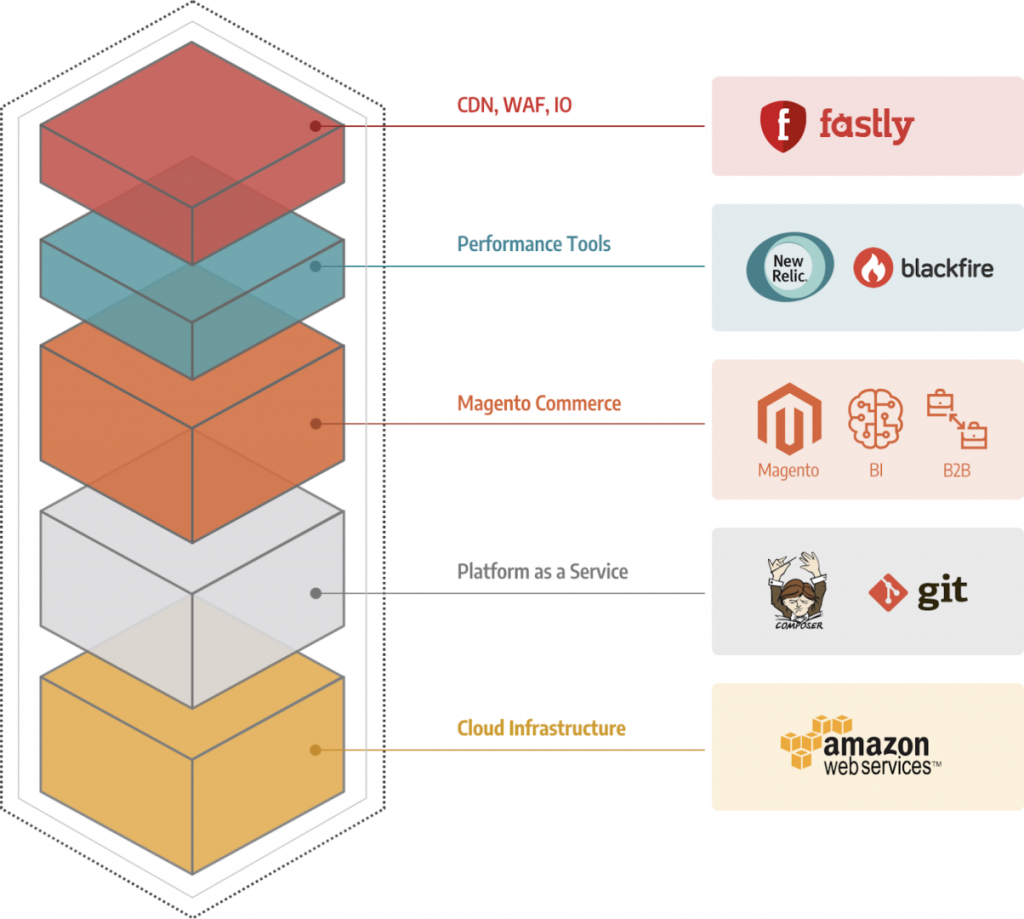
- Fastly Content Delivery Network and Varnish caching for faster page load.
- Web Application Firewall (WAF) and DDoS protection add an extra level of security.
- Performance testing tools – Blackfire Profiler and New Relic – optimize interactions between project applications.
- Git repository management – GitHub and Bitbucket – allows for fast deployment of the ecommerce solution.
- AWS Cloud or Microsoft Azure provide cloud hosting.
- Magento Business Intelligence, B2B Module, and 24/7 support facilitate commerce operations.
Besides, Magento Commerce Cloud has an often overlooked security advantage — a shared responsibility security model.
In this model, responsibility for system security is shared between Magento (Adobe), Amazon, and the merchant. In turn, this reduces costs for merchants and allows them to focus on their business and not the technology.
Magento Commerce Cloud: Pro vs Starter version
To save you time, here’s what makes Magento Commerce Cloud Pro the better version:
- Magento’s B2B module — Includes features such as smart order management, real-time inventory, optimized fulfillment costs and delivery times, automated business rules, B2B company accounts, configurable products, and quote management tools.
- Dedicated Technical Account Manager — To help you get off the ground faster and deploy your site with peace of mind.
- Infrastructure-as-a-Service (IaaS) — dedicated virtual infrastructure for Production environments and for Staging environments, which supports Dedicated Hardware and High availability infrastructure.
Now that you understand what Magento has to offer, let’s look closer at Shopify Plus main features and benefits that keep merchants on the hook.
What are the benefits of Shopify Plus over regular Shopify plans?
Shopify isn’t the new kid on the block. They’ve been around for a long time and what we like most about their approach is how quickly and effectively they adopt emerging technologies.
In a 2011 interview with Practical Ecommerce, Shopify COO Harley Finklestein stated:
“I think we’ll be at a point where the entire computing experience will be done through a dummy terminal. Effectively, the actual hardware will have very little software on it and you’ll access everything through your online connection. Even if you don’t have to have the fastest computer or one that’s loaded up with the most amount of software, you’re going to be able to access everything on the cloud or on the web, whether you’re running your ecommerce store, using Google Docs, or communicating through some sort of web-based voiceover IP.”
Harley clearly has his finger on the pulse of technology, because this prediction is unfolding as we type this.
What makes Shopify Plus a good choice for existing Shopify clients, potential clients, and merchants?
Currently, Shopify Plus presents the following features:
- advanced Shopify plug-ins designed for high-growth merchants
- a checkout that you can customize with Shopify Scripts to gain more control over the branding of your store
- additional API calls for PIM, CRM, ERP integration, or any other software to optimize your commerce operations
- the Merchant Success Program and Shopify Plus Academy to help you out with installation and track your progress
- a Launch Engineer who assists with thirt party integrations and finds partners via Shopify Plus Partner Program to work on design and development projects specifically for your business
- unlimited staff accounts to allow you to grow your personnel without additional cost risks
- nine additional storefronts for those looking forward to selling overseas and in separate locations
- up to 100 themes, including their seasonal variations, to add to your Shopify account
- permission settings for more control over the actions your employees take in the Shopify admin panel
- a B2B module that lets you create a separate, password-protected wholesale store
With the internal comparisons out of the way, let’s move on to comparing Shopify Plus vs Magento Enterprise.
Shopify Plus vs Magento 2: What are the main differences?
The whole point of paying the premium price tag for an enterprise-level ecommerce platform (as in Shopify Plus vs Magento) is getting the chance to take a step back and focus solely on your business processes.
If you have all of the underlying infrastructures in place (and secured), you worry less about something going wrong. Besides, if you factor in all of the time, money, and energy that you spend trying to upscale, optimize, and improve an existing legacy infrastructure site — you’ll see that you actually save a decent amount of money with a cloud ecommerce platform.
Which brings us to the main point — how does Magento 2 stand up to Shopify Plus and vice-versa?
Multi-Store Management
Magento
Using a single Admin panel, you can create as many storefronts as you want with multiple warehouses, physical and digital stores. Coupled with multi-currency-ready features, Magento is ideal for international merchants or those looking to get into international retail.
Shopify Plus
Shopify Plus does offer a multi-store view, but it’s limited compared to what Magento has. To be more specific, you get nine expansion stores for internationalization, separate physical locations, and other related purposes.
Merchants that exceed the nine-store threshold have the option of workarounds. Paul Rogers wrote a great guide on Shopify Plus limitations and workarounds.
Customization
Magento
One of the biggest selling points of Magento is the ability to customize any aspect of the platform — be it backend, frontend, checkout, catalog, shipping, or anything in between.
Shopify Plus
Shopify Plus is more customizable than other Shopify Plans but pales in comparison to the level of customization offered by Magento.
The platform allows merchants to write scripts for certain things, customize the checkout, and include additional API calls for integrating custom apps.
Pricing
Magento
The price for Magento Commerce Cloud starts at $40,000/year ($3,333 per month) and increases depending on your store’s Gross Merchandise Value (GMV) and Average Order Value (AOV).
- GMV is the total value of all the transactions processed through a site during any given contract year, excluding (a) any shipping, handling, and customs costs charged to end-users; (b) any taxes customer collects from end-users as part of any transaction; (c) any financing charges and interest for installments charged to End Users.
- AOV means the quotient of (a) the GMV for any given contract year; (b) the number of transactions during the same contract year.
Shopify Plus
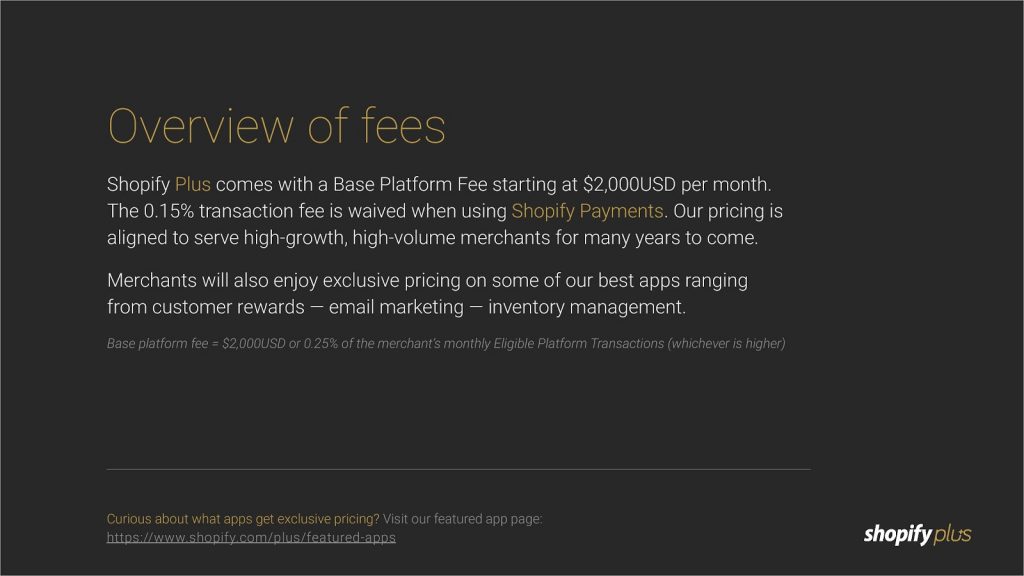
Base platform fee = $2,000/month or 0.25% of your monthly Eligible Platform Transactions (net value of any online or POS transactions processed through the store). Basically, you pay whichever fee is higher.
Scalability
If you’re looking at the purely cloud infrastructure, both platforms are equally scalable — whether it’s AWS or Google Cloud, you have more or less the same capabilities (flexibility, efficiency, strategic value).
But from a business perspective, Magento is more scalable in terms of the number of products, stores, currencies, and customizations.
Support
Magento
Magento 2 Commerce Cloud offers 24/7 monitoring and email support for the core application and the cloud infrastructure. You’ll also get dedicated technical account management for the initial launch, starting with your subscription until your initial site launch
Shopify Plus
A Launch Engineer helps your store get online faster by assisting with third-party integrations, and finding partners to work on design and development projects specifically for your business
24/7 support is standard in both Magento Commerce and Shopify Plus.
Security
Magento
Magento Cloud’s shared security responsibilities are a huge advantage for the merchant. Magento also has a bug bounty program, security center, and free security tool. Check out other aspects of Magento security in our related guide.
Shopify Plus
Shopify Plus is no less secure than Magento. It is fully PCI-compliant out-of-the-box, secured with SSL certificates, and regularly updated with security patches.
Merchandising
Magento
Ecommerce merchandising is the way of displaying products or offers on a website with the goal of increasing sales, and Magento definitely beats Shopify Plus in this regard. There are seven standard product types in Magento Commerce: simple, configurable, bundled, downloadable, virtual, grouped products, and gift cards.
You can also create rules to set up related products and take advantage of visual merchandising to position products in the catalog category.
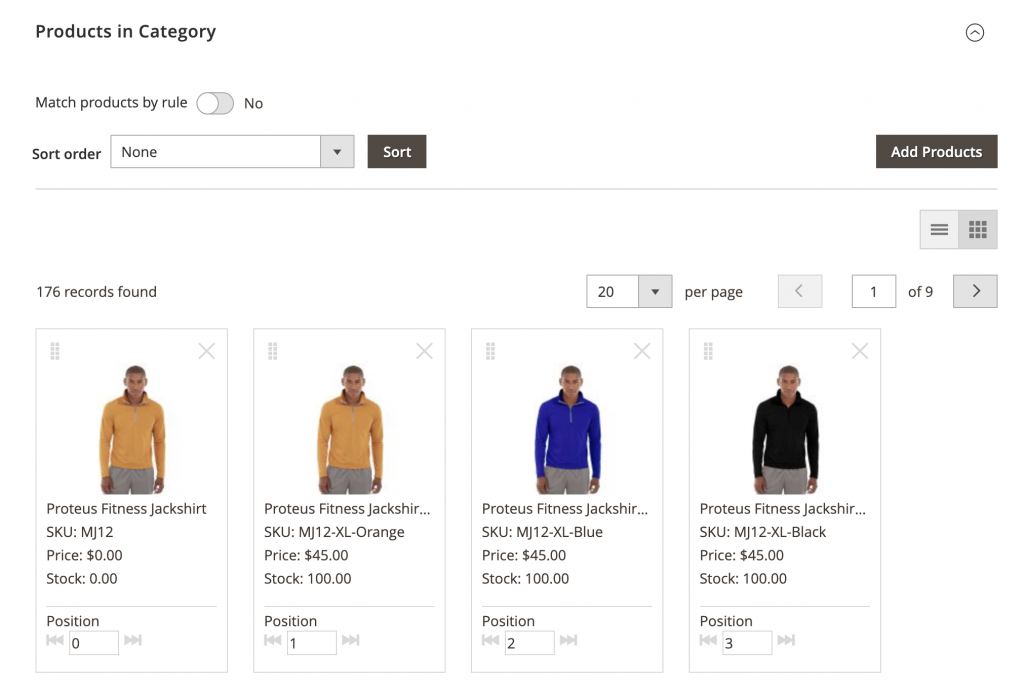
Shopify Plus
When comparing Magento vs Shopify Plus, you’ll see that Shopify offers pretty standard product types. This will be enough for a fashion retailer, for instance, but selling digital products on Shopify Plus will be more hasslesome. To access the product, your customer will need to install a Digital Downloads app.
Shopify Plus also offers a visual merchandiser function, so you can drag & drop the items on a product grid and place them in order that your customers will like the most.
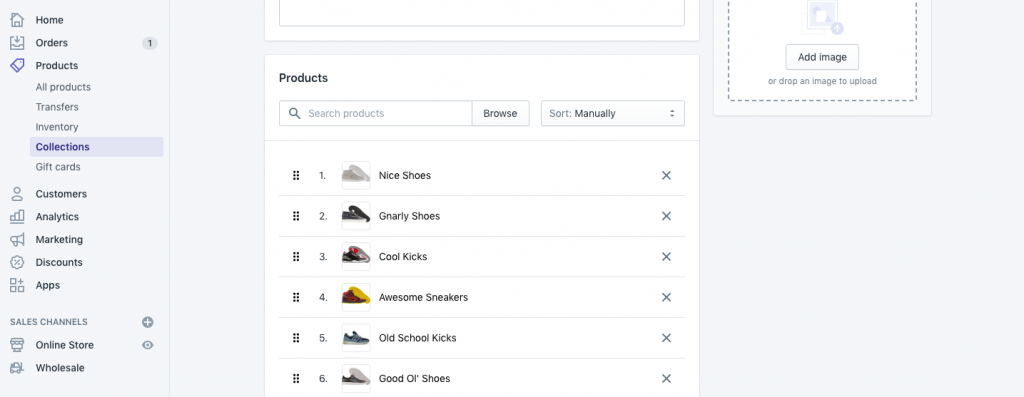
Apps, extensions integrations
Magento
Magento supports tons of extensions and API-led integrations. Because the platform is open source, you can develop a custom module on your own or customize the core code to modify the store functionality. You might not need to spend extra on add-ons, though: Magento Commerce Cloud has enough out-of-the-box features + secure hosting to serve even the largest enterprises.
Shopify Plus
Shopify is also robust when it comes to extensions. Still, it may be losing the Shopify Plus vs Magento Commerce fight in this category because the system is closed and you can’t implement any custom integrations on your own. If Shopify extensions don’t meet your business needs, you’ll need to hire a Shopify Plus developer to bypass all the platform’s limitations and add custom functionality to your store.
Payment options
Both Magento and Shopify Plus have a multitude of payment options. Neither charges transaction fees. For Magento, you’ll have three built-in payment gateways plus a dozen of custom ones (check them out in our related guide). For Shopify Plus, you’ll have Shopify Payments option if you want to avoid transaction fees for payments.
Shopify Plus vs Magento 2 Comparison Table
Let’s summarize all the features & benefits of Shopify Plus vs Magento Commerce in a nutshell.
| Magento 2 Commerce | Shopify Plus | |
| Release date | 2016 | 2014 |
| Ease of use | Complex because of open-source nature | Easy because of closed system |
| Hosting | Self-hosted and cloud-based | Cloud-hosted |
| Extensions | 6,000 | 4,000+ |
| Features | Advanced | Advanced |
| Ease of Integration | Flexible | Limited to Shopify API |
| Payment Gateways | Supports PayPal, Braintree, Authorize.net by default + custom payment gateway integrations via API | Supports 70+ payment gateways and charges no extra fee with Shopify Payments |
| Customizability | High | Low |
| SEO | Advanced | Basic |
| Security | PCI compliance, regular security patches and updates | PCI compliance, SSL certificates, regular security updates |
| Multilingual capabilities | Built-in multi-lingual support | Add-ons required |
| Multi-store view | Unlimited storefronts | Up to 9 storefronts |
| Merchandising | 7 product types supported, including digital products and gift cards + a visual merchandizer | Standard and custom product types + a visual merchandizer |
| Support | 24/7 customer support | 24/7 customer support |
| Ideal Ecommerce Size | Medium-sized and large businesses with a high-volume store | Small businesses looking for a user-friendly platform |
| Pricing | $22,000+/year for Magento Commerce Edition or $40,000+/year for Magento Cloud Edition | $2,000 per month |
Brands that switched from Shopify to Magento Commerce Cloud
This is a selection of case studies that we felt best showcase the capabilities of Magento Commerce Cloud. You can find more customer success stories here.
Rebel Athletic
5 Sites Into One Shopping Cart
+350% Holiday Sales (YoY)
+25% Mobile Traffic
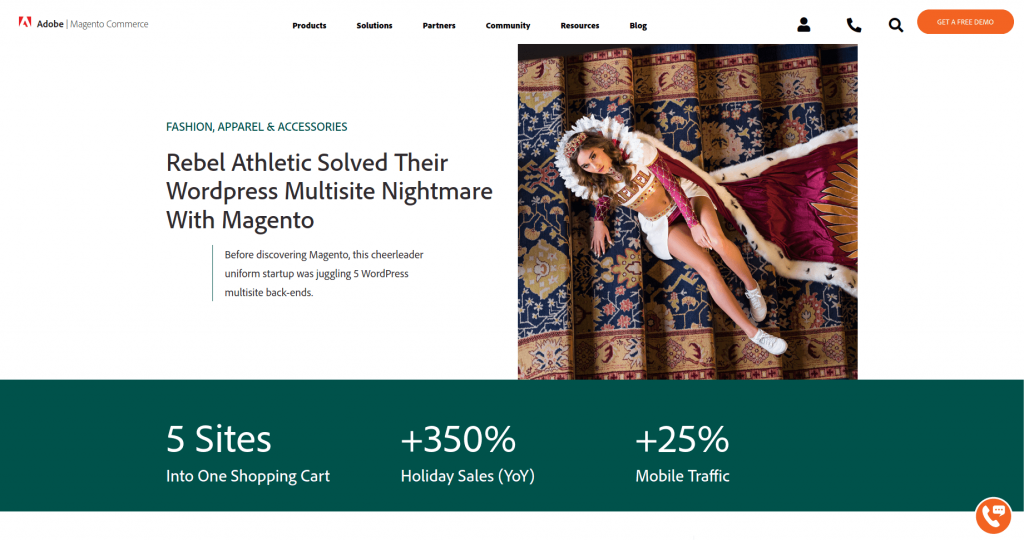
Rubik’s
150% UK Revenue (First 6mo)
+500% France Revenue Increase (YoY)
-20% Bounce Rate
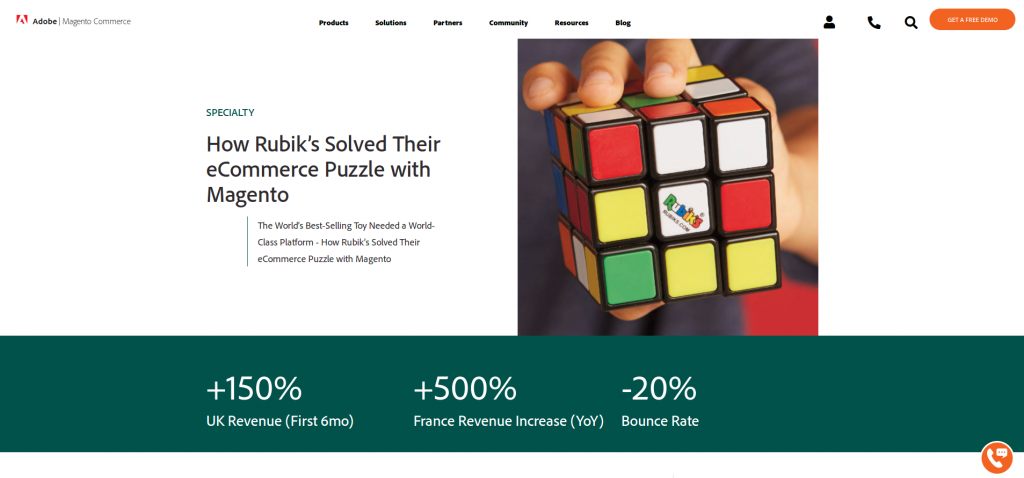
So what’s the bottom line? Magento 2 vs Shopify Plus
Honestly, the best option for choosing between Shopify Plus vs Magento 2 would be to follow this flow:
- Sit down with your team and discuss what you need from your ecommerce platform
- Choose a few vendors (if you’re doing it with outside help) and jump on a call to discuss the options.
- We also suggest scheduling a demo to take a closer look at both Shopify Plus and Magento Commerce Cloud.
- Based on these three points, you can compare the costs, features, and requirements.
The reason we distilled it down to these four actionable points is that there can be no winner in these comparisons. At the end of the day, it’s the effectiveness of your business that matters, and having the best platform is the platform will allow your business to flourish.

